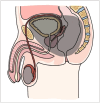[Postoperative Imaging Findings of Colorectal Surgery: A Pictorial Essay]
- PMID: 39130784
- PMCID: PMC11310425
- DOI: 10.3348/jksr.2021.0004n
[Postoperative Imaging Findings of Colorectal Surgery: A Pictorial Essay]
Abstract
Postoperative colorectal imaging studies play an important role in the detection of surgical complications and disease recurrence. In this pictorial essay, we briefly describe methods of surgery, imaging findings of their early and late complications, and postsurgical recurrence of cancer and inflammatory bowel disease.
대장과 직장 수술 후 영상 검사는 수술 후 생기는 합병증과 특정 질환의 재발을 발견하는 데 있어 중요한 역할을 한다. 이 임상화보에서는 개략적인 대장과 직장 수술 방법, 영상 기법, 수술 후 조기 및 후기 합병증의 특징적 영상 소견, 암 재발 또는 염증성 대장 질환의 특징적 영상 소견에 대해서 다룰 것이다.
Copyrights © 2024 The Korean Society of Radiology.
Conflict of interest statement
Conflicts of Interest: The authors have no potential conflicts of interest to disclose.
Figures

















References
-
- Hohenberger W, Weber K, Matzel K, Papadopoulos T, Merkel S. Standardized surgery for colonic cancer: complete mesocolic excision and central ligation--technical notes and outcome. Colorectal Dis. 2009;11:354–364. - PubMed
Publication types
LinkOut - more resources
Full Text Sources

